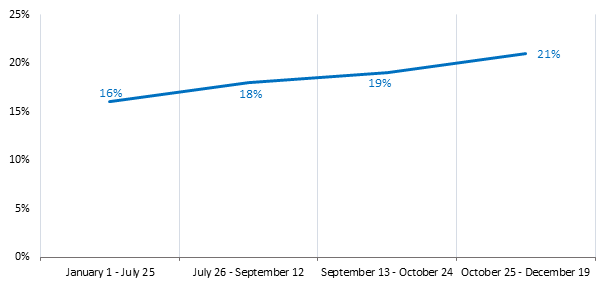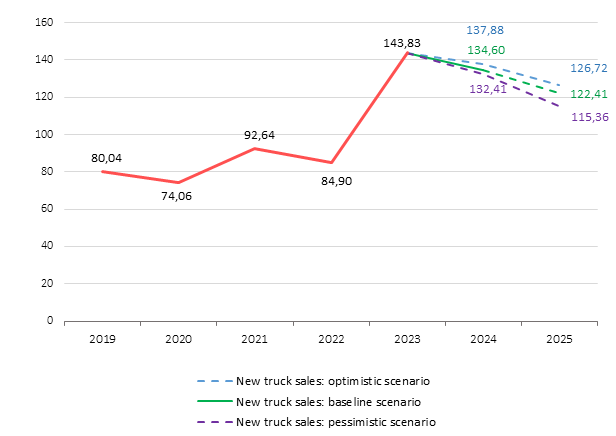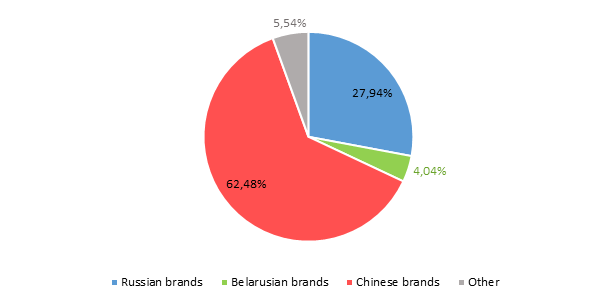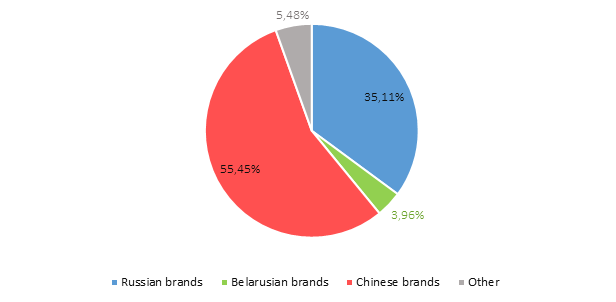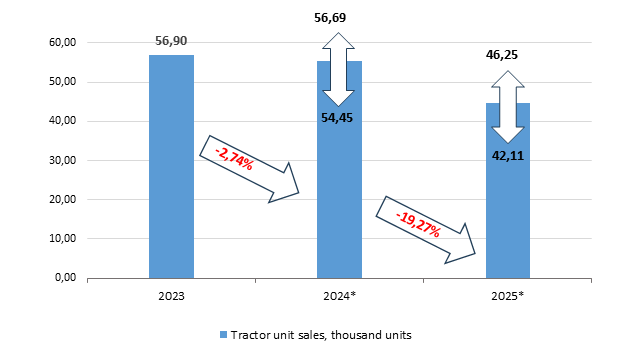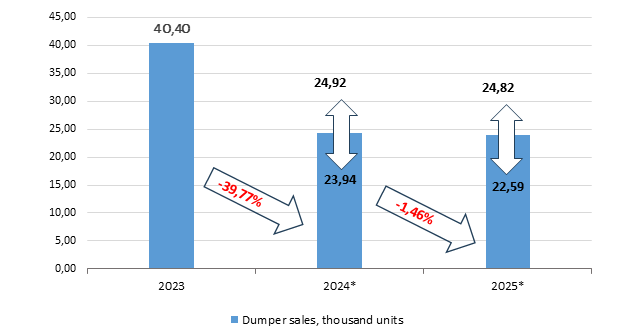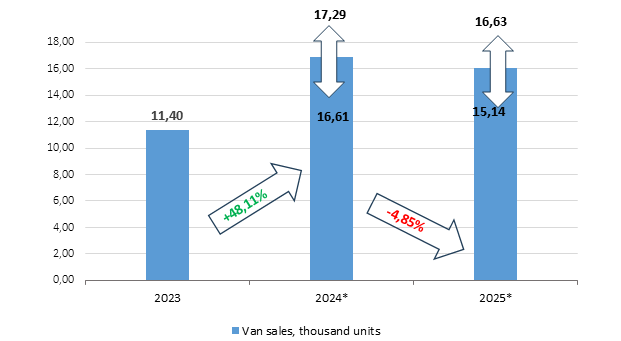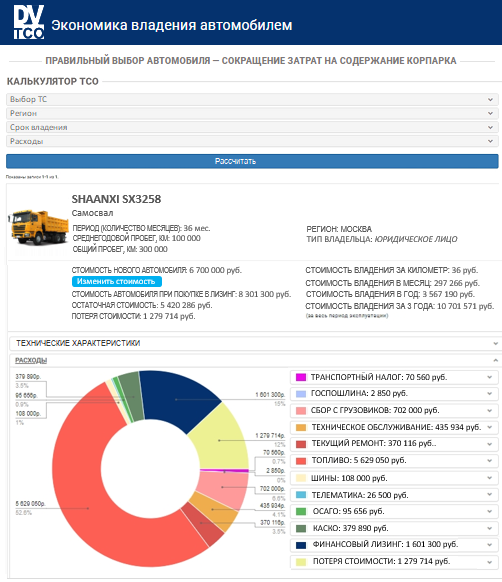
20.11.2024 / How many trucks will be sold in 2025
The new truck market forecast (vehicles with GVW over 6 tons) is based on three scenarios: baseline, optimistic and pessimistic.
According to all three forecast scenarios, the following factors had a negative impact on the Russian automotive market:
1. Sanctions (EU, USA and other countries). After February 24, 2022, economic sanctions were imposed against the Russian Federation, which also affected the automotive market. There is a ban on the export of trucks, automotive components, spare parts, technologies and equipment to the Russian Federation. Based on global political trends, we assume that sanctions against the Russian Federation will remain in 2024-2025. The impact of sanctions on new truck sales is not high, since most of the vehicles previously supplied from countries that have announced sanctions against the Russian Federation has been replaced with Chinese, Russian and Belarusian ones. Moreover, a small amount of foreign vehicles is supplied under parallel import.
2. High loan and leasing interest rates. Since the beginning of 2024, there has been a gradual increase in the key rate of the Central Bank of the Russian Federation (see chart). The last increase in the key rate took place on October 25, 2024. The Central Bank of the Russian Federation raised the key rate to 21%. This rate is valid until December 19, 2024. On December 20, a meeting of the Board of Directors of the Bank of Russia will be held, which will consider the issue of the further level of the key rate. With the growth of the key rate, the loan and leasing interest rates increased, which made these financial instruments less affordable. The negative impact of high leasing and loan interest rates will remain until the end of 2024 and in 2025. Leasing and loan interest rates will depend on the key rate of the Central Bank of the Russian Federation, which may be increased after December 20, 2024.
Change in the key rate of the Central Bank of the Russian Federation in 2024
Source: Central Bank of the Russian Federation
3. The growth of recycling tax and stricter conditions for certification of imported vehicles. Beginning April 1, 2024, the Government of the Russian Federation decided to include taxes and fees that were not paid due to underestimation of the customs value of vehicles imported into the Russian Federation from the EAEU countries into the recycling tax. On October 1, 2024, recycling tax rates significantly increased for all vehicle types, including trucks. On January 1, 2025, recycling tax rates will be indexed again. Given that Russian manufacturers that have signed the SPIC are compensated for the recycling tax costs in the form of industrial subsidies, its increase primarily has a negative impact on prices for imported vehicles, primarily those manufactured in China.
Since October 1, 2023, certification of vehicles of those brands that have not stopped official deliveries to Russia and are not included in the list of brands allowed for parallel import has been carried out under the Technical regulations "On the safety of wheeled vehicles". Vehicle Type Approval is issued for vehicles of these brands, previously it was possible to issue Conclusion on the Assessment of a Single Vehicle under a simplified procedure. Legal entities are required to install the ERA-GLONASS system when importing vehicles. These requirements will remain until the end of 2024.
Beginning 2025, it is planned to revise the mechanism for registration of Conclusion on the Assessment of a Single Vehicle and tighten the rules for vehicle certification not only for importers, but also for manufacturers. Instead of the simplified certification rules prescribed in Resolution No. 855, some requirements of the Technical regulations "On the safety of wheeled vehicles" may be returned. The relevant draft law is under consideration.
The growth of recycling tax and stricter conditions for certification of imported vehicles results in increase in truck prices, which has a negative impact on the market.
4. Market oversaturation. Many carriers, construction leasing companies, and companies from other fields of activity purchased trucks in 2023 and not intensively update and expand their fleets in 2024. The new truck market will remain oversaturated in 2025.
5. Low level of investment in the automotive industry and the market. Since 2022, contract assembly of trucks of such foreign brands as Volvo, Mitsubishi Fuso, Isuzu etc. has been discontinued in Russia. Since August 2023, the conditions for importing trucks in the Russian Federation have been tightening (growth of recycling tax, complication of certification of imported vehicles, etc.). In this regard, it is necessary to invest into the creation of new truck production facilities on the territory of the Russian Federation for the further market development.
Chinese manufacturers assemble only small volumes of trucks at the Russian plant facilities and do not announce their plans to invest into the development of production of their brands in the Russian Federation in the coming years. New players from other countries do not plan to enter the Russian market.
In 2024-2025, only Russian manufacturers will invest in core activities, while the government will invest in existing truck production. Such investments may lead to an increase in the share of Russian brands in the truck market, but they will not significantly affect the total volume of truck sales in the Russian Federation.
6. Tax reform in 2025. In 2025, tax reform will be carried out in the Russian Federation and the tax burden on companies and individual entrepreneurs will increase. It will lead to a further increase in prices for trucks, spare parts, service, etc.
On January 1, 2025, excise taxes on gasoline and diesel fuel, as well as fares for travel on federal public roads by vehicles with GVW of over 12 tons (Platon system) will be indexed, which will have a negative impact on the total cost of truck ownership.
Against the background of the growing tax burden, high auto loan and leasing rates and rising prices, a number of companies and individual entrepreneurs will have reduced financial capacity to renew their truck fleets.
Nevertheless, there are factors that make it possible to smooth out the negative trends in the new truck market in 2024-2025.
1. State support measures for the truck market.
In 2024, state support measures are in place for the truck market. First of all, these are preferential leasing programs. In 2024, the preferential leasing programs cover only tractor units and unmanned trucks, but not all trucks. 17 billion rubles were allocated for these programs in 2024 (tractor units, unmanned trucks, buses, minibuses, and electric cars). In 2025, the preferential leasing programs will continue with a budget of 11 billion rubles (for all types of vehicles that will fall under the program).
Moreover, in 2024, trucks will be subject to procurement under the program for converting vehicles to natural gas fuel under Decree of the Government of the Russian Federation No. 669 dated 05/13/2020 and procurement of vehicles running on all types of fuel - under the "Safe Quality Roads" national project. Moreover, trucks for agriculture will also be purchased under the state program for the development of agriculture and regulation of raw materials and food markets. However, under this program, only a small amount of equipment based on wheeled vehicles will be purchased (mainly tractor-based equipment and tracked vehicles are purchased).
2. Financial programs from manufacturers.
Against the background of the key rate increase, manufacturers and leasing companies are developing and offering their loan and leasing programs to consumers at more attractive interest rates than standard rates from banks and leasing companies.
3. Standard truck replacement cycles.
In 2024 and 2025, old, worn-out and broken down trucks will be retired from the fleets of private and corporate vehicle owners and replaced with new ones.
4. The growth of distances and volumes of cargo transportation.
Due to the sanctions, the western direction for road transportation was actually closed. EU countries have stopped allowing vehicles registered in Russia and Belarus since April 2022, and the ban has even affected transit traffic (with the exception of transit to the Kaliningrad region). In 2022-2024, logistics companies began to actively use alternative ways of delivering goods to the Russian Federation (the route through the Republic of Belarus, the Turkish hub, the Silk Road (Russia – Kazakhstan – China), etc.). Increased transportation distances lead to the growth in time of cargo transportation, which requires an additional number of trucks.
Moreover, an increase in the vehicle cargo turnover is expected in 2024-2025. In January – September 2024, the vehicle cargo turnover (all types of vehicles) increased by 7.7%.
5. Development of the newly annexed territories to the Russian Federation (DPR, LPR, Kherson and Zaporozhye regions).
New territories require the purchase of new trucks to carry out construction work, restore public infrastructure and ensure the transportation of goods.
According to all forecast scenarios, mainly Russian, Chinese and Belarusian brands will continue to be sold in the Russian truck market in 2024-2025. New vehicles imported under parallel import and those of foreign brands manufactured on the territory of the People's Republic of China and "friendly" countries to the Russian Federation will also be sold.
In 2024-2025, the new truck sales composition is expected to change.
Tractor units
Increase in distances and volumes of cargo transportation, implementation of a preferential leasing program, as well as deferred demand caused by a shortage of tractor units in 2022 had a positive impact on tractor unit sales in 2023-2024. According to the baseline, optimistic and pessimistic forecast scenario, sales may decrease in 2025. This may be due to the tractor unit market oversaturation in 2023-2024. The deferred demand for new tractor units was satisfied in 2023-2024, and in the new 2025, the purchase of a smaller volume of vehicles will be required.
Moreover, in 2025, high loan and leasing rates, increase in the recycling tax for these vehicles and stricter conditions for their certification will have a negative impact on tractor unit sales.
Dumpers
In 2023, a record number of new dumpers were sold over the past few years. In 2024, significantly fewer dumpers are being purchased than in 2023, which indicates that the deferred demand for them was satisfied last year and large volumes of vehicles are not required.
The pace of housing construction and construction of commercial real estate is expected to slow down in 2025, but road construction projects will be implemented under the "Safe Quality Roads" national project and other federal and municipal programs, as well as infrastructure restoration projects in the newly annexed territories to the Russian Federation (DPR, LPR, Kherson and Zaporozhye regions). These infrastructure projects may require the purchase of dumpers.
Nevertheless, the volume of dumper sales may decrease slightly in 2025 against the background of a general decline in the truck market. Moreover, in 2025, high loan and leasing rates, increase in the recycling tax for these vehicles and stricter conditions for their certification will have a negative impact on dumper sales.
Vans
Van sales will grow in 2024, which is due to the release of the deferred demand for this vehicles. Foreign van manufacturers have left the Russian market, and these vehicles are gradually being replaced with Russian and Chinese brands.
By 2025, the deferred demand for vans will be released and sales of these vehicles may decrease slightly. A sharp increase in logistics is not expected next year, and there are no special government programs to upgrade these vehicles.
Moreover, in 2025, high loan and leasing rates, increase in the recycling tax for these vehicles and stricter conditions for their certification will have a negative impact on van sales.
The baseline forecast scenario assumes the following:
2024
- the key rate of the Central Bank of the Russian Federation may be increased by 1-2 percentage points after December 20, 2024, which will lead to a further increase in the cost of loans and leasing,
- the macroeconomic situation in Russia will remain difficult. GDP in 2024 may grow by 3.0% on 2023, inflation will be 8.2%.
2025
- the key rate of the Central Bank of the Russian Federation in 2025 will remain at the level of December 2024, lending and leasing of trucks will remain expensive,
- the macroeconomic situation in Russia will remain difficult. GDP in 2025 may grow by 1.6% on 2024, inflation will be 5.0%.
The optimistic forecast scenario assumes the following:
2024
- the key rate of the Central Bank of the Russian Federation will remain at the level of 21% after December 20, 2024 and there will be no significant increase in the cost of lending and leasing,
- the macroeconomic situation in Russia will remain difficult. GDP in 2024 may grow by 3.3% on 2023, inflation will be 8.0%.
2025
- the key rate of the Central Bank of the Russian Federation may decrease by several percentage points in 2025, lending and leasing of cars will become more affordable,
- the macroeconomic situation in Russia will remain difficult. GDP in 2025 may grow by 1.9% on 2024, inflation will be 4.5%.
The pessimistic forecast scenario assumes the following:
2024
- the key rate of the Central Bank of the Russian Federation may be increased by more than 2 percentage points after December 20, 2024, which will lead to a further increase in the cost of loans and leasing of trucks,
- the macroeconomic situation in Russia will remain difficult. GDP in 2024 may grow by 2.8% on 2023, inflation will be 8.5%.
2025
- the key rate of the Central Bank of the Russian Federation will continue to grow in 2025, therefore, loan and leasing interest rates will increase,
- the macroeconomic situation in Russia will remain difficult. GDP in 2025 may grow by 1.4% on 2024, inflation will be 6.2%.
New truck sales forecast for 2024-2025
| Sales forecast, scenario |
Truck sales forecast in 2024, thousand units | Growth/loss, 2024/2023, % | Truck sales forecast in 2025, thousand units | Growth/loss, 2025/2024, % |
| Optimistic scenario | 137882 | -4.14 | 126718 | -8.10 |
| Baseline scenario | 134597 | -6.42 | 122411 | -9.05 |
| Pessimistic scenario | 132407 | -7.94 | 115356 | -12.88 |
Source: NAPI (National Industrial Information Agency)
New truck market forecast till 2025, thousand units
* forecast
Source: NAPI (National Industrial Information Agency)
New truck market composition forecast in 2024,
baseline scenario
Source: NAPI (National Industrial Information Agency)
New truck market composition forecast in 2025,
baseline scenario
Source: NAPI (National Industrial Information Agency)
New tractor unit market forecast till 2025, thousand units
* forecast
Source: NAPI (National Industrial Information Agency)
New dumper market forecast till 2025, thousand units
* forecast
Source: NAPI (National Industrial Information Agency)
New van market forecast till 2025, thousand units
* forecast
Source: NAPI (National Industrial Information Agency)
СКАЧАТЬ файл >>>
